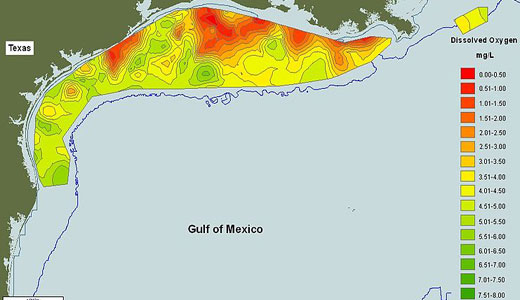
An oxygen-devouring algae bloom is causing a 5,840 square-mile dead zone in the Gulf of Mexico – that’s 2,940 square miles larger than last year. The growing issue has been linked to fertilizers and pesticides used on farms in the Midwest, but there’s a bigger picture. Many Republicans in Congress, who have vehemently denied the existence of climate change, would have one believe that any claims of climate alteration are baseless. But there’s an easily discernable pattern, in this case, that proves that to be false.
Dead zones are oxygen-deprived areas in oceans and large lakes, which suffer from an overabundance of certain nutrients and, often, pollutants. The dead zone in the Gulf was first identified in 1950, but did not become a major problem until much later (think very recently). The correlation between the dead zone and the Mississippi River, which is the drainage area for 41 percent of the continental U.S., is obvious. High-nutrient runoff, such as nitrogen and phosphorous, is dumped into the Gulf from the river, and most of that comes from Midwest agricultural practices. But that’s only one ingredient in the deadly cocktail that is responsible for what is also referred to as the “hypoxic zone” of the Gulf.
In 2010 – the year of the Deepwater Horizon oil spill – the dead zone was the largest it had ever been; the size of New Jersey. There, too, exists a link. When oil decomposes, it consumes oxygen. So, for one of the largest oil spills of all time to occur in a body of water already suffering from hypoxia…well, you do the math. And despite BP’s claims to the contrary, there are still remnants of that crude in the Gulf, the effects of which could linger for decades. This could foil any efforts made to lessen or alter the pesticides used on Midwest farms to mitigate the problem. It’s a complicated issue, and it gets worse.
The very same area of land from which nutrients drain into the Gulf also just happens to be the site of numerous factory-scale meat farms. To be clear, the Midwest is the most heavily-concentrated area of factory farms in the country. And factory farms are big trouble. It is a profit-hungry industry that relies heavily on dangerous chemicals: pesticides, to curb disease and bacteria; and antibiotics and hormones, to stimulate rapid livestock growth. Ethics and animal welfare are not even part of the equation. The factory farming industry is capitalism to the nth degree. And the swath of chemicals and animal waste from these factories gets dumped into lakes and rivers (often illegally), where it eventually runs off into the Mississippi River – and you can imagine where it goes from there. Factory farming is very much a contributor to the dead zone.
Genetically-modified crops, another gift from corporations, also come into the picture. GMO corn and soybeans make up a large part of the diets of cattle, who are imprisoned and tortured in unsanitary conditions. GMO corn carries a toxin that makes it poisonous to a pest called the rootworm; that toxin also builds up and eventually drains into the Gulf. The modified crops also cause said rootworm to become more resistant, thus facilitating the need for farmers to “up the dosage” of pesticide.
So are there ways to curb what is being pumped into these waters? A 2012 study by Iowa State University suggested that there might be. It found that by mixing in one or two other vegetables with the Midwest’s corn and soy crops, farmers could reduce the need for nitrogen fertilizer by 80 percent. Also, instead of leaving fields empty during the winter (this massively contributes to soil runoff), farmers could occupy those spaces with cover crops.
But the average farmer would not associate the deep problems in the Gulf with corn crops; nor would many animal rights activists link the dead zone to the very cruel factory farms they are fighting. It’s very possible that this is due to the fact that the national dialogue on this issue is sorely lacking. The problems in the Gulf are often cited as “another product of climate change.” But not going into greater detail, and not tracing the issues to their multiple sources, results in a truncated assessment of the overall problem. And that opens the door for Republicans to write that assessment off as another part of “the leftist global warming conspiracy.”
On Aug. 14, conservative talk show host Rush Limbaugh claimed that climate change is not happening; that human activities are not having any negative effects on the environment, because “you must be either atheist or agnostic to believe that man controls something he can’t create.”
But one thing disproves that sort of statement: the simple lineage of disastrous human practices, which some experts have traced all the way down the line from corporate profiteering, to animal cruelty, to illegal chemical dumping. It is all connected, and unless greater social and environmental responsibility is exercised, hypoxic zones like the one in the Gulf will grow and multiply.
It is ironic that the very Republicans who deny climate change exists are actually contributing to it, through their support of corporations: corporations like Monsanto, which manufacture harmful pesticides; corporations like BP, that engage in offshore oil drilling amidst spills and leaks; corporations that, if given the chance, will damage areas like the Gulf so badly that New Jersey-sized dead zones will become a permanent fixture in the already-blackened water.
Photo: The dead zone in the Gulf, as it appeared in 2011. (Wikipedia/NASA & National Oceanic and Atmospheric Administration)












Comments